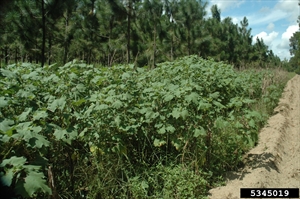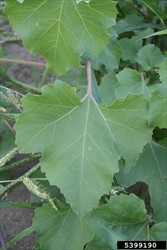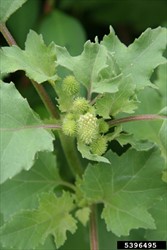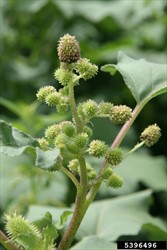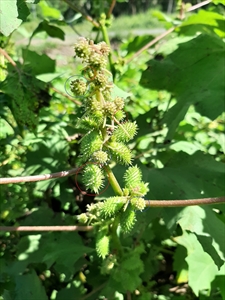- Widespread. Asia, Africa, North America, Caribbean, Europe, Oceania. In Fiji, New Zealand, PNG.
- Forming large stands on disturbed land: grassland-woodlands, water courses, floodplains, dry sandy riverbeds, roadsides, ditches, wasteland. Also, a weed of row crops (soybeans, cotton, maize, peanuts), plantations and pastures. Invasive weediness due to tolerance of soil types, climates, ease of spread.
- Annual, erect, multi-branched stems, up to 150 cm, with short dark streaks, and short stiff hairs. Leaves, opposite (lower), or alternate (upper) along stems, dark green, triangular, up to 20 cm long, margins toothed, and surfaces with bristles. Male flowers in clusters at top of branches, female below with hooked spines. Fruits, brown, hard, woody with two grey or black seeds, flattened on one side
- Spread: burrs, by animals; clothing; water; roadmaking materials; vehicles.
- Biosecurity: high risk of introduction: seeds easily spread.
- Biocontrol: moths, Euaresta aequalis, and Epiblema strenuana; beetles, Mecas saturnina and Nupserha vexator, introduced to Australia, but not yet successful.
- Cultural control: hand weeding, hoeing, slashing or mowing; inter-row cultivation; vehicle hygiene.
- Chemical control: in Australia: 2,4-D; 2,4-D + picloram; glyphosate (and Fiji); fluroxpyr; metsulfuron-methyl; MCPA.
Pacific Pests, Pathogens and Weeds - Online edition
Pacific Pests, Pathogens, Weeds & Pesticides
Noogoora burr (471)
Noogoora burr; it is also known as cockleburr, or common cockleburr.
Xanthium strumarium. It is also known as Xanthium pungens and Xanthium occidentale. It is a member of the Asteraceae.
AUTHORS Grahame Jackson, Aradhana Deesh & Mani Mua
Adapted from Noogoora burr (Xanthium occidentale) (2018) Weeds of SE Qld and Northern NSW. Lucidcentral. (https://www.lucidcentral.org/editors-pick-animal-and-plant-identification-keys/key-to-weeds-of-se-qld-and-northern-nsw); and additional information from CABI (2019) Xanthium strumarium (common cockleburr). Invasive Species Compendium. (https://www.cabi.org/isc/datasheet/56864); and Noogoora burr Xanthium pungens (2020) Department of Agriculture and Fisheries. The State of Queensland. (https://www.daf.qld.gov.au/__data/assets/pdf_file/0008/77723/IPA-Noogoora-Burr-PP17.pdf); and from Xanthium strumarium L. (2016) Weeds of Australia. Biosecurity Queensland Edition. Queensland Government. (https://keyserver.lucidcentral.org/weeds/data/media/Html/xanthium_strumarium.htm). Photo 1 David J. Moorhead, University of Georgia, Bugwood.org. Photo 2 Jan Samanek, Phytosanitary Administration, Bugwood.org. Photo 3-5 Robert Vidéki, Doronicum Kft., Bugwood.org. Photo 7 Bruce Ackley, The Ohio State University, Bugwood.org.
Produced with support from the Australian Centre for International Agricultural Research under project HORT/2016/185: Responding to emerging pest and disease threats to horticulture in the Pacific islands, implemented by the University of Queensland, in association with the Pacific Community and Koronivia Research Station, Ministry of Agriculture, Fiji.
